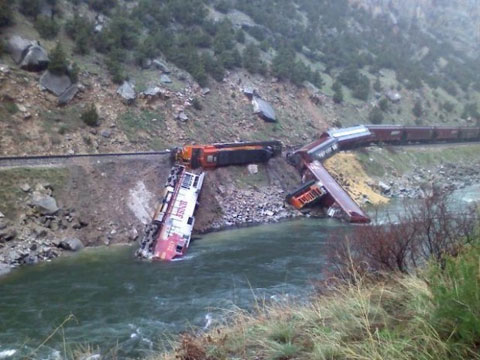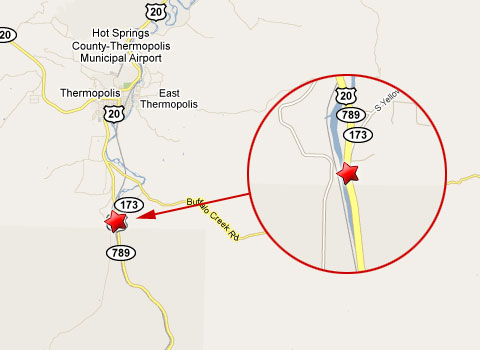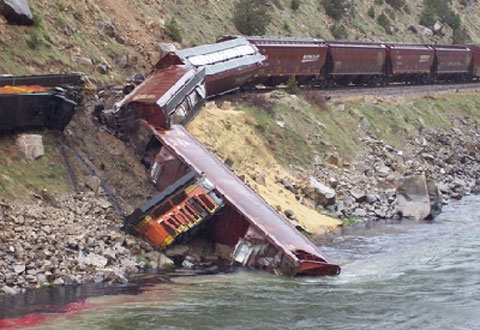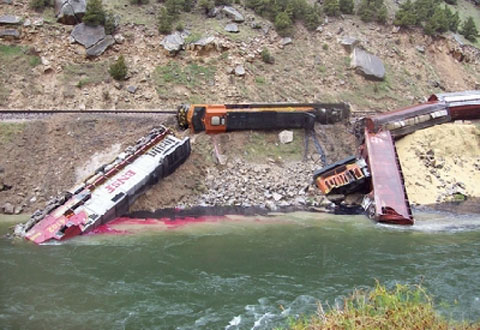THERMOPOLIS, WY – According to railroad officials, a Burlington Northern Santa Fe Railway (BNSF) train derailed on May 12, 2010 around 12:30 p.m. The derailment occurred along a 50-foot embankment alongside the Wind River about five miles south of Thermopolis at the north end of the Wind River Canyon.

One BNSF locomotive lies partly in the river while another lies on its side halfway down the embankment of the Wind River after the derailment on May 12, 2010 just south of Thermopolis, WY.
According to BNSF spokesman, Gus Melonas, the train originated in Laurel, MT. It was destined for Denver, CO when the derailment occurred.
The train was traveling about 30 mph when it struck a rock slide about 5 miles south of Thermopolis, Wyoming. The train hit a boulder the size of a pickup truck then sent two engines and a rail car into the Wind River.

Location of the BNSF train derailment alongside the Wind River about 5 miles south of Thermopolis, WY at the north end of the Wind River Canyon.
The 62-car train with its two-person crew was hauling general freight at the time of the derailment. Although 17 of the cars were empty at the time, the train was hauling 45 loads. The freight included lumber and paper products.
Two engines were derailed in the incident. According to Melonas, one of the locomotives was halfway down the embankment on its side and the second one was partially in the river.
One of the locomotives was torn into two sections and was leaking diesel fuel and oil into the river. Several towns located downstream from the derailment, including Thermopolis, had suspended drinking water treatment supplies to their communities as a result of the incident. Shortly after 2:00 p.m. local authorities reported that the water supply to Thermopolis and Lucerne had been secured.

A torn section of the second locomotive is shown resting against a derailed freight car.
The water contamination caused by the derailment was significant. Local authorities stated that over 15,000 gallons of fuel had leaked from the derailed locomotives. The cleanup efforts could take months.
By around 6:00 p.m. Thermopolis was operating on reserve water tanks and wells to supply the community. Although much of spilled fuel and oil had moved down river from the derailment site, crews had established booms and were working to siphon off the remainder.
Thermopolis Search and Rescue was called in and used rescue boats to transport the railroad employees to the west bank of the Wind River. Remote access to the derailment site hampered rescue efforts. Access to the west side of the river was limited.
The two railroad workers were able to escape from each locomotive through the engineer’s door. They were taken to a local hospital for further observation.

This angle shows the two derailed locomotives and a freight car. The force of the derailment split one of the locomotives into two sections. One of the engines lies partly in the river.
According to an eye witness from the Wyoming Highway Patrol, the railroad company was notified about the rock slide that led to the derailment but was unable to notify the train crew in time. Two more rock slides had been reported on the east road side of Wind River Canyon. One of the other rock slides resulted in an accident involving a car.
Ambulances were dispatched to The Boysen Dam 12 miles upriver to treat at least one hypothermia patient who was reported to be in critical condition. At least two people have been transported to The Thermopolis Regional Medical Center for treatment with hypothermia and contaminant injuries.
Gordon & Elias, LLP, are top nationwide FELA lawyers representing railroad workers injured on the job who need experienced attorneys knowledgeable in the Federal Employers’ Liability Act (FELA). For more information and expert advice, call 800.773.6770.